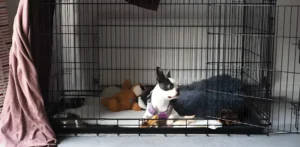Your dog’s cries or whines are a way of communicating. It could be a simple request for food, an urgent need for a bathroom break, or signal something more serious like pain or anxiety. Understanding the reasons behind their vocalizations is the first step towards finding a solution that helps both you and your furry friend.
Common Reasons for Canine Whining
1. Basic Needs: Dogs may whine when they need to go outside, want food or water, or desire playtime and exercise.
2. Pain or Discomfort: If your dog’s whining is new or accompanied by other behavioral changes (lethargy, hiding), they might be hurt or ill. A prompt veterinary checkup is essential.
3. Anxiety: Separation anxiety, fear of loud noises, unfamiliar environments, or changes in routine can all make dogs whine due to stress.
4. Attention-Seeking: Some dogs learn that whining gets them what they want, whether it’s petting, treats, or simply your focus.
5. Excitement: Whining mixed with other happy body language (tail wags, jumping) might just be your dog’s way of expressing pure joy!
Less Common, But Important Causes
- Breed Predispositions: Certain breeds like huskies, hounds, and herding dogs are known to be more vocal than others.
- Cognitive Decline: Older dogs with cognitive decline may whine due to confusion, disorientation, or increased anxiety.
Whining “Soundbites”

While all dogs whine, the specific sound can offer clues to their emotions:
The High-Pitched Whimper: This short, repetitive whine often indicates a basic need like wanting to go outside or needing playtime.
The Low-Frequency Whine: A prolonged, low-pitched whine may signal discomfort or deeper anxiety. Pay close attention to your dog’s body language (tucked tail, flattened ears) for further context.
Urgent, Repetitive Whining: This rapid, insistent whine could mean your dog is in pain and requires immediate veterinary attention. Don’t ignore it.
What to Do: Decoding and Addressing Your Dog’s Whines
Observe: Pay attention to the context. When does the whining start? What else is your dog doing (posture, activity, environment)?
Rule Out Medical Issues: Consult your veterinarian, especially if the whining is excessive, out of character, or accompanied by other concerning symptoms (loss of appetite, vomiting, lethargy).
Respond to Basic Needs: Ensure your dog has regular potty breaks, fresh water, appropriate meals, and sufficient exercise tailored to their breed and age.
Mental Enrichment: Training sessions, puzzle toys, and safe chews can combat boredom and keep your dog mentally stimulated.
Tackling Anxiety: Consult a dog trainer or behaviorist for strategies tailored to your dog’s anxiety triggers, such as crate training, desensitization techniques, or counterconditioning (teaching a positive behavior to replace the whining).
Avoid Reinforcing Unwanted Whining: Don’t give in to attention-seeking whines. Instead, reward calm behavior with praise or a treat.
Seeking Expert Help

When in doubt about your dog’s whining, your veterinarian is your best ally. Here’s why consulting them is important:
Ruling Out Medical Causes: Whining that’s unusual, excessive, or comes with other symptoms might indicate an underlying health issue. Vets have the expertise to diagnose and treat these problems.
Personalized Advice: Every dog is unique. Your vet can give you tailored guidance based on your dog’s age, breed, and the specific context of their whining.
Peace of Mind: Knowing you’ve addressed any potential health concerns and have a plan of action can significantly reduce your worry and help you focus on solutions for your furry friend.
Age-Specific Considerations
Puppies: Puppies may whine more frequently due to teething discomfort, needing to eliminate more often as they adjust to potty training, and anxiety from being in a new environment. Provide plenty of chew toys, establish a consistent potty schedule, and create a safe and cozy space for them.
Senior Dogs: Cognitive decline, vision/hearing loss, and increased pain sensitivity can lead to more whining in older dogs. Be patient, ensure their environment is easy to navigate, and consult your vet about pain management options if needed.
Success Stories
Buddy the Beagle: When Whining Meant Illness
“Buddy, a playful Beagle, started whining excessively and seemed lethargic. His owner noticed he wasn’t interested in his favorite treats. A trip to the vet revealed Buddy had a bladder infection. Prompt treatment got Buddy back to his energetic self, and his whining ceased. This story highlights the importance of veterinary care when whining is accompanied by other symptoms.“
Sasha the Shepherd: Beating Separation Anxiety
“Sasha, a German Shepherd, would whine incessantly whenever her owner left for work. A certified dog trainer helped Sasha’s owner develop gradual desensitization strategies and crate training techniques. With patience and consistency, Sasha learned to cope with being alone, and the whining decreased significantly.“
Conclusion
Constant whining can be frustrating for both you and your dog. Understanding the reasons behind it allows you to address the root cause and find solutions that promote your dog’s well-being and your own peace of mind.
The photo featured below the post headline is Credit: TOSHIHARU ARAKAWA/istockphoto
I hope you find this post helpful and informative. If Yes’ feel free to share it with your friends!
Frequently Asked Question
My dog whines at night. What should I do?
Ensure they had a potty break, aren’t hungry, and have a comfortable sleeping space. If they continue, a vet check is needed.
How do I stop my dog from whining for attention?
Ignore the whining, and only engage with them when they are calm.
Is it okay to crate my dog if they whine?
Crate training can be effective for some dogs, but it shouldn’t be used as punishment or if they have separation anxiety.
Can whining be a sign of aggression?
If whining is accompanied by growling, snarling, or tense body language, consult a behaviorist for safety reasons.
Why is my dog whining so annoying?
It’s natural to find persistent whining frustrating. Dogs whine to communicate, and understanding the reason can help you find solutions and regain peace and quiet.
Why is my female dog whining all of a sudden?
Sudden whining in female dogs could be due to hormonal changes (heat cycles), underlying medical issues, or anxiety. Observe other behavioral changes and consult a vet if needed.
How to stop dog anxiety whining?
Seek guidance from a dog trainer or behaviorist for personalized strategies. These could include crate training (if appropriate), counterconditioning techniques, or medication in severe cases.
Why is my dog whining while lying down?
Whining while lying down could indicate discomfort, pain, or difficulty getting up, especially in older dogs. Veterinary attention is recommended.
Is my dog whining because he’s bored?
Yes! Whining can be a sign of boredom or lack of mental stimulation. Increase playtime, provide puzzle toys, and ensure your dog gets sufficient exercise.
Do dogs whine when they’re in pain?
Whining is often one of the ways dogs signal pain. If accompanied by other changes like lethargy, hiding, or appetite loss, a vet check is crucial.
How can I tell if my dog is whining for attention?
Attention-seeking whines usually start when you’re present and stop when you ignore them. Redirect your dog to a chew toy or engage in a brief training session instead.
Why does my dog whine when I pet him in certain places?
This could indicate a sensitive spot or underlying pain. Observe your dog’s reactions and consider a vet visit if it persists.
Can certain foods make my dog whine more?
While uncommon, food sensitivities can sometimes contribute to discomfort and behavioral changes, including whining. Talk to your vet if you suspect a dietary link.










